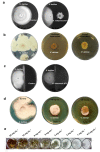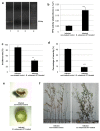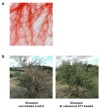Biological Control of Verticillium Wilt on Olive Trees by the Salt-Tolerant Strain Bacillus velezensis XT1
- PMID: 32698452
- PMCID: PMC7409040
- DOI: 10.3390/microorganisms8071080
Biological Control of Verticillium Wilt on Olive Trees by the Salt-Tolerant Strain Bacillus velezensis XT1
Abstract
Verticillium wilt, caused by the pathogen Verticillium dahliae, is extremely devastating to olive trees (Olea europea). Currently, no successful control measure is available against it. The objective of this work was to evaluate the antifungal activity of Bacillus velezensis XT1, a well-characterized salt-tolerant biocontrol strain, against the highly virulent defoliating V. dahliae V024. In vitro, strain XT1 showed to reduce fungal mycelium from 34 to 100%, depending on if the assay was conducted with the supernatant, volatile compounds, lipopeptides or whole bacterial culture. In preventive treatments, when applied directly on young olive trees, it reduced Verticillium incidence rate and percentage of severity by 54 and ~80%, respectively. It increased polyphenol oxidase (PPO) activity by 395%, indicating an enhancement of disease resistance in plant tissues, and it decreased by 20.2% the number of fungal microsclerotia in soil. In adult infected trees, palliative inoculation of strain XT1 in the soil resulted in a reduction in Verticillium symptom severity by ~63%. Strain XT1 is biosafe, stable in soil and able to colonize olive roots endophytically. All the traits described above make B. velezensis XT1 a promising alternative to be used in agriculture for the management of Verticillium wilt.
Keywords: Bacillus velezensis; Olea europaea; Verticillium dahliae; antifungal activity; biocontrol; crop protection.
Conflict of interest statement
DC was a full-time employee of Xtrem Biotech S.L., company that holds an exclusive license agreement on the patent that protects
Figures




References
-
- Ruggieri G. A new disease of olive. L’Italia Agric. 1946;83:369–372.
-
- Keykhasaber M., Thomma B.P.H.J., Hiemstra J.A. Verticillium wilt caused by Verticillium dahliae in woody plants with emphasis on olive and shade trees. Eur. J. Plant Pathol. 2018;150:21–37. doi: 10.1007/s10658-017-1273-y. - DOI
-
- Berlanger I., Powelson M.L. Verticillium wilt. Plant Heal. Instr. 2000 doi: 10.1094/PHI-I-2000-0801-01. - DOI
-
- Landa B.B., Pérez A.G., Luaces P., Montes-Borrego M., Navas-Cortés J.A., Sanz C. Insights into the effect of Verticillium dahliae defoliating-pathotype infection on the content of phenolic and volatile compounds related to the sensory properties of virgin olive oil. Front. Plant Sci. 2019;10:1–12. doi: 10.3389/fpls.2019.00232. - DOI - PMC - PubMed
Grants and funding
LinkOut - more resources
Full Text Sources
Molecular Biology Databases

